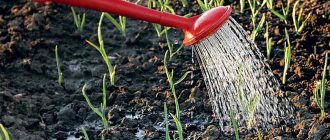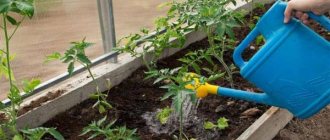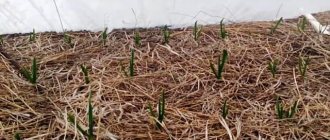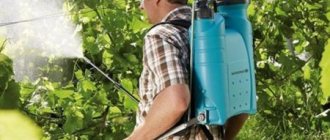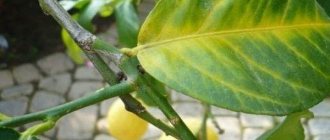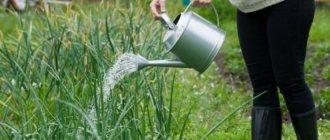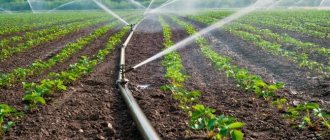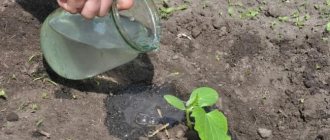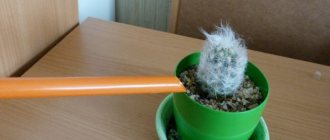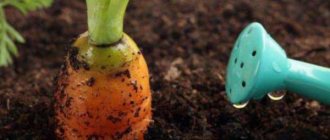Basic rules for watering raspberries
Seasonality is the first criterion that is important to consider when choosing a raspberry watering regime.
It is also necessary to take into account that irrigation water should not be too hard and have a temperature significantly different from the ambient temperature . It is best to use the bottom (root) type of watering and carry out this procedure in the evening or early morning, until the sun begins to intensively illuminate the area.
Important! The general rule is this: the plant needs maximum moisture immediately before entering the flowering phase and then at the time of crop formation.
in spring
Spring is the time of awakening of plants and the formation of young shoots, on which fruit formation will occur. However, during the period of intense snow melting, the raspberry tree does not need moisture, so the gardener can devote the beginning of the new season to organizing the irrigation system, and not to the watering itself.
And only in the southern regions, where intensive growth of bushes begins in late April - early May, is it time to start moderate watering . At first, water consumption can be 0.5–1 liters of water per bush, and then, as the soil warms and dries out, this figure gradually increases to 2–3 liters.
In summer
In the central zone of the European part of the Russian Federation and more northern regions, watering raspberries begins at the beginning of summer and continues until the bushes begin to bloom. Then you should take a short break, allowing the plant to form ovaries, after which, as fruit formation occurs, moisten the soil regularly, but not too often.
Did you know? Legend associates the beginning of raspberry cultivation in Muscovy with the name of Yuri Dolgoruky, the son of Vladimir Monomakh and Prince of Rostov-Suzdal, considered the founder of the modern capital of the Russian state.
By mid-summer, when the shrub is in the final phase of berry formation, the plant needs to be watered less frequently , only when the soil is very dry, otherwise the fruits will ripen unsweetened and will quickly deteriorate. In addition, waterlogging during this period is fraught with the development of fungal infections on the berries, in particular gray rot.
After the bush has fruited, the purpose of watering is to maintain the depleted strength of the plant, but water consumption at this time should be moderate.
Video: Watering berry crops
in autumn
By the end of summer and beginning of autumn, watering should be gradually reduced to a minimum. During this period, it is impossible to create favorable conditions for the plant to form new shoots, since such green mass does not have time to form, freezes out in the winter and only takes away from the bush the strength it needs to prepare for the onset of frost.
However, in late autumn, immediately before covering the raspberries for the winter, the bushes need to be watered once and abundantly. This procedure will prevent freezing of the root system, the likelihood of which increases sharply in dry soil.
Important! The cooler the weather, the less frequent watering should be. This rule applies even in cases where the summer was cold but not rainy.
How to feed raspberries?
General rules for feeding raspberries:
- Plants that have enough nutrition should not be fed. Fertilizers are applied only at low and medium levels of nutrient availability in the soil.
- Fertilizing is carried out before loosening the soil.
- The effectiveness of fertilizing increases if it is carried out in conjunction with irrigation (300-400 cubic meters of water per hectare).
Nitrogen fertilizers are useful in spring Fertilizer is incorporated into the soil by loosening. And after loosening, the soil under the bushes is mulched with organic matter (compost, humus or straw manure) at the rate of 6 kg per m2. The procedure is repeated annually. A solution is also used: 1-1.5 matchboxes of ammonium nitrate per 10 liters of water. Each bush is watered from a watering can with a strainer, and then carefully loosened so as not to damage the roots.
in summer and autumn : Phosphorus and potassium supplements are recommended once every 3 years. For this, use: Superphosphate at the rate of 120-150 g per 1 m2. Potassium sulfate at the rate of 90-120 g per 1 m2.
useful to feed raspberries in the summer, in June , when the ovary is still green, with a solution of slurry or bird droppings. This feeding is recommended for high yields or poor plant growth. If you are a little late, no problem, feed the raspberries during the ripening of the berries and fruiting , that is, in July . However, such belated fertilizing will have less effect on the harvest than at the beginning of summer. Mullein solution is prepared in a ratio of 1 to 10 with water. A bucket is enough to water 1 square. meters. At a distance of 20 cm from the bushes, grooves are made with a rake and the solution is poured into them. Once absorbed, cover with soil. Not only raspberries, but also currants and gooseberries love this summer feeding.
Organic fertilizers (peat, compost, rotted manure) are applied annually the fall before digging. Many berry crops (raspberries, gooseberries, currants) require such fertilizing after picking the berries. In autumn, the soil under the bushes is sprinkled with organic matter and dug up (at some distance from the bushes so as not to damage the roots). Then, during autumn feeding, it is recommended to add superphosphate (10 g per 1 m2) in combination with potassium salt.
We found such data in the reference book “Encyclopedia of Country Life”. Another reference book, “Fruit Growing” (USSR times), gives the following recommendations on how to feed raspberries:
Apply the following amount of fertilizer per 1 hectare annually to raspberries:
- 30-40 tons of manure (3-4 kg per square meter),
- 1 -1.5 kg of ammonium nitrate (10-15 g per square meter),
- 1.6 - 2.4 quintals of superphosphate (16-24 g per square meter),
- 0.6 - 0.9 quintals of potassium chloride (6-9 g per square meter).
Rates vary depending on the condition of the soil and plants.
Fertilizers are poured into grooves or holes located on both sides of the row (distance 40-50 cm from the base of the bush).
What does the watering regime depend on?
The correct choice of moisture regime for raspberries depends not only on the time of year, but also on many other factors. In particular, it is important:
- variety (regular or remontant, early or late ripening varieties, degree of drought resistance, etc.);
- climatic conditions (duration of summer, average temperatures and amount of snow in winter, regularity of precipitation, strength and intensity of wind);
- age of the bush (young plants need more moisture to gain strength);
- current weather situation, etc.
Early ripening berry varieties should be watered intensively and approximately evenly from late spring to mid-summer. Medium-ripening varieties are moistened in two stages - at the beginning and end of the period of watering early raspberries. As for late varieties , they are watered throughout the entire season, from the last month of spring until autumn (adjusted for weather).
3.1. Raspberry care in July
Raspberries are harvested in July. It is recommended to do this once every 2 days. Spoiled fruits are collected in a separate container.
Watering in July, as in June, is required. The bushes need moisture to produce berries. In extreme heat and drought, the raspberry tree is watered every 3 days.
The row spacing is also mulched, and the rows are sprinkled with compost or humus to inhibit the growth of weeds. Sprouted weeds are removed, small shoots are cut out.
Important
Collected spoiled berries should not be thrown on the ground. They may contain raspberry beetle larvae.
Watering methods
Watering raspberries from a watering can, as our ancestors did, is a labor-intensive and irrational option. You can resort to it if only a few fruit bushes are planted on the site. But even they grow so densely over time that it is physically quite difficult to carry the entire volume of irrigation water.
In addition, the superficial root system of raspberries reacts very sensitively to temperature changes, so you cannot water the plant with cold water . All this leads to the fact that the raspberry moistening system must be automated.
Did you know? In addition to red and yellow, there are also black raspberries. However, the rarest are the purple berries, which were bred at the end of the 19th century in Geneva by crossing red and black berries.
Drip
Drip irrigation is a modern irrigation system that has no equal both in terms of minimizing the labor costs required to care for the beds and in terms of economical water consumption. The method involves running special tapes along the rows between the bushes, each of which has tiny holes at a certain distance from each other. Using simple connecting devices, the tapes are connected to the water supply; as a result, the water entering them through droppers slowly and evenly saturates the soil exactly at the points where it is needed.
The only drawback of the method is the need to purchase special equipment for its arrangement, as well as the expenditure of some effort and creativity to assemble and install the system. It should be noted that modern drip irrigation systems are not too expensive and the water savings they provide make it possible to recoup the costs incurred . Therefore, even in small raspberry fields, organizing such irrigation makes sense.
The above is true provided that the summer resident always has access to a centralized water supply. In the absence of an organized water supply, when the gardener is forced to constantly or periodically collect rainwater for irrigation , automated irrigation of the raspberry tree must be organized using more complex methods, for example, trench or irrigation ditch.
Video: Drip irrigation of remontant raspberries
Trench
The essence of the trench method is to, on the one hand, keep irrigation water around the bush for as long as possible, and not spread over the entire area, and on the other hand, to prevent damage to the roots of the plant by the strong pressure of water, which is usually achieved by using a hose.
Drip irrigation system
This method of irrigating raspberries is most often used to reduce labor costs. You can take a closer look at how to make the necessary device yourself.
How to do it yourself?
To create such a system you will need the following:
- container with water;
- water supply generator;
- distribution manifold;
- drip tape or drip hose;
- valves to control water flow.
Important. It is not recommended to use metal containers, since corrosion processes, which are natural, will lead to clogging of the entire system.
You can collect it in different ways. The main thing is that water is supplied from the tank after opening the tap. Next, the water is supplied through a hose to the raspberry bushes. At the same time, each hose should also be equipped with a tap, because it is not always necessary to water the entire raspberry tree.
Equipment selection
You need to know how to choose the right equipment. Here are some recommendations:
- It is better to buy a plastic tank. It can be purchased at a specialty store.
- Hoses are sold in coils. You can buy plastic or rubber.
- The taps should be metal, as their service life is longer.
Important. There are several types of drippers: with a fixed moisture flow, adjustable, compensated, non-compensated and spider type, which can irrigate several bushes at once.
It is necessary to choose one or another method of irrigating the raspberry tree, based on the characteristics of its location. At the same time, it is possible to carry out drip irrigation of other crops growing in a summer cottage. True, then the tank should be quite large.
It is highly recommended to use water filters to prevent the system from becoming clogged. They are installed immediately at the water outlet from the tank. Filters need to be changed periodically. The frequency of change depends on the quality of the water.
Operating rules
Drip irrigation systems are often used on an industrial scale. But summer residents also often use it on their plots. Basic operating rules:
- First you need to make sure that there is electricity, since with the help of a generator the water is supplied further.
- Then you need to check that there is enough water in the tank.
- First, the valves at the ends of the system open, then the main one.
- After watering, the entire system must be turned off in the reverse order.
Reference. This irrigation takes longer than manual watering. But the summer resident is on the site for a long time, so the raspberries will have time to receive a sufficient amount of moisture.
Watering remontant raspberries
When purchasing raspberries, it is very important to clarify whether the variety is regular or remontant. In the latter case, the bush is able to form fruits on both biennial and annual shoots, which from a practical point of view means receiving not one, but two harvests from such a plant during the season. True, the quantity and quality of such a harvest is usually lower than that of conventional varieties.
The main feature of watering remontant raspberries is determined by the presence of two successive phases of fruiting in the plant , for each of which it is necessary to provide standard conditions used for ordinary raspberries only once per season. These rules boil down to the fact that maximum watering of the plant is carried out until the beginning of flowering, then a gradual decrease in the intensity of moisture follows, and after the bush has fruited, it only needs to be slightly strengthened, preventing it from drying out.
In practice, the irrigation regime for remontant raspberries comes down to the introduction of one additional stage of enhanced irrigation, which, depending on the climatic zone, may occur at the beginning, middle or end of August
Raspberry care in June
For those who don’t know how to care for raspberries in June, let’s say that the most important element of caring for this month is rationing the shoots. In mid-June, the plant forms basal shoots. When the height of the shoots is up to 40-50 cm, they are normalized. Up to 6-8 strong branches are left per bush, located closer to the mother plant. Shoots up to 60-90 cm high are pinched - 4-5 cm are cut off from the top.
In June, timely watering is important.
Drying out the soil is not allowed. It is better to use drip irrigation. In early June, the plant is fertilized with organic matter - 5 liters of solution per bush.
How to water raspberries with urea solution in spring
Fertilizers cannot be applied to dry soil: the nutrients contained in them cannot be absorbed by the plant, but the root system may well receive a chemical burn. Therefore, the feeding scheme for raspberries is inextricably linked with watering.
Traditionally, in the spring, all plants first of all need nitrogen. It is this mineral that ensures the active growth of green mass, on which buds, flowers, ovaries and fruits will subsequently form.
What care does raspberries need in summer?
Caring for raspberries in summer requires a careful approach. During fruiting, the plant receives a lot of attention. Irrigation alone is not enough to produce a crop. Raspberries need weeding and fertilizing, loosening the soil and mulching, as well as trimming unnecessary stems.
Irrigation with nitrogen application
As an equivalent replacement for urea when watering raspberries in spring, you can use another nitrogen fertilizer - ammonium nitrate. This drug is used in the same way as urea, but the concentration of the working solution can be increased by 15–20%. Some gardeners recommend using ammonium nitrate in a concentration lower than urea. Therefore, in order not to make a mistake, it is better to proceed from the equivalence of these fertilizers.
Did you know? Approximately every second raspberry bush grown in the world grows in Russia, but Poland occupies the leading position in terms of production and export of this berry. Every year this country supplies about 100 thousand tons of raspberries to the world market, and approximately the same amount is consumed within the state.
In addition, nitrogen can be used in complex fertilizers, for example, nitroammophosphate. The concentration of the working solution is 30–40 g per 10 liters of water, the fertilizer consumption is standard.
When to treat raspberries against diseases and pests
Prevention of fungal diseases: didimella (purple spot), anthracnose and septoria (white spot) comes down to growing raspberries in ventilated, sparse plantings, without waterlogging the soil, excessive application of nitrogen fertilizers and weeds. Bordeaux mixture, HOM and Topaz help in the fight against them. It is advisable to complete chemical treatments at least 30 days before the raspberry harvest!
Pests - raspberry fly, raspberry beetle, gall midge, raspberry mite, spider mite, various caterpillars, aphids - are fought with the help of special preparations (Akarin, Kinmiks, Biotlin, Kleschevit, Senpai) and folk methods (infusions of garlic, onion peels, ash) . If raspberry shoots are damaged, they are removed: severely affected shoots must be cut out entirely, and slightly affected tops should be cut off. Cut shoots, fallen leaves and mummified berries must be burned!
During flowering, the emerging beetles early in the morning can be shaken off onto the litter (preferably on oilcloth, dark is preferable, the pests are clearly visible on it) and destroyed. The larvae go into the ground to spend the winter, so the entire “harvest” needs to be collected, and in a container from which they cannot get out.
Read more: Raspberry-strawberry weevil
Features of drip irrigation of plants in the fields
Irrigation is an important factor in regulating the yield of vegetables, berries, fruits and grapes.
Without watering, the fruits often turn out to be substandard, the plants die, and the farmer suffers losses. Watering ensures guaranteed yield, and therefore profit. For this purpose, fields are equipped with automatic drip irrigation systems (ADI). Field irrigation systems include:
- water source (open reservoir or well);
- water intake with pump and water supply meter;
- automation and control unit for drip irrigation;
- irrigation water filtration system;
- underground pipelines;
- above-ground flexible pipelines - layflat;
- fertilizer supply unit (injector);
- area air valves;
- accessories - taps, start connectors, plugs, fittings;
- drip tapes or tubes for each row of plants.
Technical parameters of an automatic drip irrigation system for 10 hectares of raspberries:
- average irrigation rate 1500 m3;
- irrigation norm for the season is 15-20 thousand m³;
- water flow of one dropper is 1.8-3.6 l/h;
- water consumption per 10 hectares – 2-3 thousand l/h;
- distance between droppers 0.33 m;
- outer diameter of tubes and tapes 16 mm.
